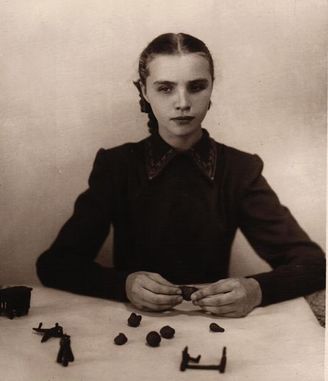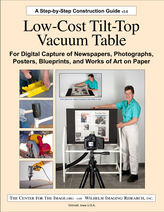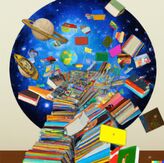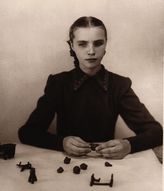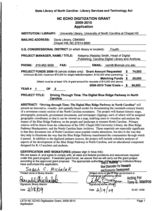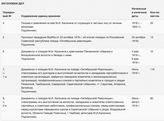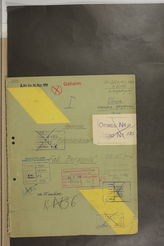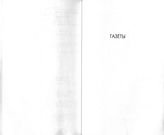Материалы в работе
Current research:
- Internet Archive announces broader crawler scope Published on 24th April 2017 by Gareth Halfacree
- поставки газетной бумаги упали до минимума 10 лет — интернет вытеснил традиционные печатные издания.
- The American Institute of Physics provides grants of up to $10,000 annually to help process archival and manuscript collections in physics, astronomy, geophysics, optics, and other related fields. Since its inception in 1998 the program has helped to fund 70 processing projects.
The deadline for 2017 is August 18. For guidelines and a list of previous recipients see: https://www.aip.org/history-programs/niels-bohr-library/previous-grants-archives.
We fund three or four grants a year, and to the best of our knowledge the AIP Grants to Archives programs is unique. (archives listserv announcement) -
"NEH awards $173,833 grant to VMFA to digitize Louis Draper archive
Project will enhance access to works by leading 20th-Century African American artist
The National Endowment for the Humanities has awarded the Virginia Museum of Fine Arts a $173,833 grant to digitize, preserve and share its archive of photographs, negatives and other materials from Richmond-born photographer Louis Draper (1935–2002). In the 1960s and 1970s, Draper played an influential role in capturing the vantage point of African Americans during the civil rights era, elevating their photographic representation beyond stereotypes often depicted in popular media. In 1963, he was a founding member of the Kamoinge Workshop, a collective of African American photographers.
In March 2016, VMFA announced the acquisition of Draper’s archive, which is anchored by 2,822 photographs, 42,116 negatives, 748 contact sheets, 4,378 color and black-and-white slides, 36 computer-generated images, and 71 computer disks, as well as his camera equipment and more than 80 linear inches of valuable archival documents and publications. The museum had originally acquired 13 of his photographs in 2013.
“This significant addition to our collection recognizes our vision to put the VMFA in the forefront in collecting and disseminating the works of African American artists,” said Alex Nyerges, VMFA Director. “In just a few years, our museum has become the go-to venue for Draper’s amazing works, both as a photographer and as an educator. With this grant, we can ensure the preservation of these photographs and related materials for future generations to explore and learn from, as this archive offers an unparalleled window into a transformational moment in our nation’s history. Draper gave us a different and meaningful perspective each time he clicked the shutter on his camera.”
“Making art accessible is at the heart of VMFA’s mission, and this goes hand-in-hand with our strategic plan to expand our collection of African American art,” said Stephen D. Bonadies, VMFA’s Senior Deputy Director for Conservation and Collections, who will oversee the Draper digitization project. “This is our largest special collection and the first to consist of extensive and varied photographic and archival materials. Not only will this project allow us to improve our stewardship and care of these works, but it will also enable us to virtually share this incredible resource with visitors from across America and even the world.”
Two major art museums are borrowing works from VMFA’s Draper holdings. The Tate Modern in London will open Soul of a Nation: Art in the Age of Black Power in July 2017, while the Cleveland Museum of Art has Black in America: Louis Draper and Leonard Freed on display now. Locally, five of Draper’s prints—including two from the new archive—are included in A Commitment to the Community: The Black Photographers Annual – Volume 1, the first of a four-part exhibition series at VMFA that explores each of the four volumes of the Black Photographers Annual, a publication produced and edited by members of the Kamoinge Workshop and published between 1973 and 1980. That exhibition, on view until October 3, 2017, already has become a destination for a large number of visitors, including public school children.
“NEH provides support for projects across America that preserve our heritage, promote scholarly discoveries, and make the best of America’s humanities ideas available to all Americans,” NEH Chairman William D. Adams said. “We are proud to announce this latest group of grantees who, through their projects and research, will bring valuable lessons of history and culture to Americans.”
The grant is from the NEH’s Humanities Collections and Reference Resources program, which supports projects that provide an essential underpinning for scholarship, education, and public programming in the humanities. The program funds implementation, and planning and pilot projects. In this round of competition, the program awarded grants to 39 of the 224 applicants.
The Draper archive at VMFA is a valuable primary resource that will allow scholars, educators, curators, and the public to explore multiple humanities themes through Draper’s experience and work as an African American photographer—including his recognition of his photography as a form of “engaged resistance” that not only bore witness to leaders of the civil rights movement, but also offered a richer and more diverse perspective of African American life than provided by the mainstream media. Draper’s materials also include a significant portion on the early history of the Kamoinge Workshop and document his perspective on the professional challenges that he and the collective confronted in the process of finding publications that would publish photographs of African Americans made by African Americans. His photographs of significant 20th-century artists, writers, musicians, and performers reflect the wide array of personal connections that Draper made after moving to New York from Richmond, Virginia in 1957. Printed photographs and contact sheets in Draper’s archive show a broad view of city life and the everyday interactions between people and also offer a unique vision of African American neighborhoods in the 1960s and 1970s.
The grant will fund staff resources to digitize the archive and rehouse the photographs. Dedicated physical and digital storage will be built, and analog audiovisual and born-digital materials will be reformatted to contemporary digital standards. When the project is complete, the archive materials will be made accessible through a custom portal on the VMFA website. The museum also will create educational resources to teach adults and K-12 educators about Draper, the Kamoinge Workshop and their part in the history of photography. The 29-month project will start on July 1, 2017.
“Very rarely does a museum acquire such a comprehensive archive by an artist and his colleagues. This archive will allow us to tell an unprecedented story rooted here in our city and show Louis Draper’s relevance in so many different contexts,” said Dr. Michael Taylor, Chief Curator and Deputy Director for Art and Education. “This archive includes the artist’s extraordinary street photographs, the supporting documents of the Kamoinge Workshop, and everything else we need to tell a complete story. This is a major draw for VMFA, and, thanks to NEH’s support, our digitization effort will allow us to make this story accessible beyond the museum’s walls.”
In January 2020, to celebrate the launch of the online Draper archive, VMFA will host a major exhibition with a scholarly catalogue featuring Draper’s photographs, as well as works by other significant photographers that participated in the early years of the Kamoinge Workshop. Dr. Sarah Eckhardt, Associate Curator of Modern and Contemporary Art, will curate that exhibition.
Nell Draper Winston, Louis Draper’s sister, who initially approached VMFA about her brother’s photographs and archive, echoed her delight that this grant will allow more people to learn about his work and craft. “This project by VMFA will help elevate Louis’ work, starting right here in his hometown,” she said. “I’m proud that VMFA has recognized the value of this archive and has found a way to make Louis’ photography and experience available to everyone. My hope is that people will see the world through the lens of his camera and will go out and make their own contributions.”
In 2014, VMFA received a $40,000 grant from NEH to develop the technical requirements and workflow for the museum’s digitalization initiatives. The grant also supported efforts to digitize about 750 archival documents related to its Fabergé and Russian Decorative Arts collection.
About Louis Draper and The Kamoinge Workshop
Louis Draper was born and raised in Richmond, Va., and moved to New York City in 1957. He took classes at New York University’s Institute of Film and Television as well as at the New School for Social Research where he studied with the influential photographer Eugene Smith. He also established relationships with several major African American literary and artistic leaders, such as Langston Hughes and Roy DeCarava. In 1963, Draper was instrumental in forming the Kamoinge Workshop, a collective of African American photographers meeting in New York City. (The group’s name means “a group of people acting and working together” in Gikuyu, the language of the Kikuyu people of Kenya.) While the artists did not work alongside each other, they met weekly to show each other their work and frequently exhibited together. In 1982, the photographer Carrie Mae Weems credited the efforts of Draper and Kamoinge as “the first steps taken by black photographers to come together and form a comprehensive group that would address in photographic terms the description of being black in America.” While the group organized several shows in their own gallery space in the mid-1960s, they also had exhibitions at New York’s International Center for Photography and the Studio Museum in Harlem." (from archives listserv announcement) -
NISO Educational Programs, April 2017
Read on to learn more about our April webinar and the planned Virtual Conference on OER!
NISO Webinar: Trends in Presentation & Delivery: Publishing Experts Speak
Wednesday, April 12, 2017
1:00 – 2:00pm (Eastern)
The objective of this session is to gather input from consultants, content and technology providers as to their perspective on emerging technologies that might transform (or at least enhance) the presentation and delivery of information to researchers and scholars. What visions do they have for enhancing information environments and resources? What possibilities get them excited? What “Next Big Thing” do they see? It may be on the fringes now, but it might just as easily go viral!
Confirmed Speakers: Simone Taylor, Publisher, Open Access, Wiley; Deni Auclair, Chief Financial Officer and Senior Analyst, DeltaThink; Jake Zarneger, Chief Product Officer, Silverchair.
All speaker abstracts are now available and registration is open. Remember that Library Standards Alliance members automatically receive access to the full 2017 series of NISO webinars as a benefit of that membership.
NISO Virtual Conference
Opening Up Education: Textbooks, Resources, Courseware & More
Wednesday, April 19, 2017
11:00am – 5:00pm (Eastern)
The 21st century educational environment demands a certain amount of re-thinking and re-design of classroom support for learning – textbooks, information resources, and interactive courseware. An emphasis on cost-containment and accessibility suggests that education will become more open. This virtual conference will address the complexities of delivering instructional tools and digital resources in the increasingly open educational ecosystem. What is a textbook? Is it engineered into an online learning environment, with content, study aids and quizzes delivered as appropriate to a personalized student experience? What is the long-term role of Open CourseWare, as created by the likes of MIT or Yale? What does a growing interest in OER suggest for the various stakeholders? What types of technological support may be necessary?
Access to an associated NISO Training Thursday webinar on April 27 is included in your registration for this virtual conference.
Confirmed Speakers: Mary Lou Forward, Executive Director, Open Education Consortium; Rahim Rajan, Senior Program Officer, Gates Foundation; Julie Lang, OER Coordinator, Teaching and Learning with Technology, Penn State University; Rupert Gatti, Founder and Co-Director, Open Book Publishers; Dr. David Wiley, Founder and Chief Academic Officer, Lumen Learning; Ashley Miller, Educational Technologist, Ohio State University; Melissa Russell, Director of Content Strategy, and Mike Matousek, Director of Content Initiatives, Cengage Learning
About Registration: Purchase of a single registration to a NISO virtual conference entitles you to gather an unlimited number of staff from your organization/institution in a class- or conference room setting to view the event on the day of the live broadcast. It also includes access to an archived recording of the event to allow those with conflicting obligations to still benefit from the day’s content.
For specifics on registration costs and additional information provided by our speakers, please see the NISO event page. - The Social Networks and Archival Context (SNAC) Project
-
"Research and Development. SNAC's research and development work is demonstrating the feasibility of separating the description of people from the description of the historical records that were created by them and that document their lives and work. This separation serves two complementary objectives: improving the economy and effectiveness of archival description and providing researchers with a novel tool that integrates access to distributed historical records and reveals the social context within which the records were created.
-
Cooperative Program. The SNAC Cooperative Program (SNAC-C) has archive, library, and museum members. The long-term objective of the Cooperative is an ever-expanding international membership that will together build an ever-expanding corpus of reliable descriptions of people linked to and providing contextual understanding of the historical records that are the primary evidence for understanding their lives and work.
The Cooperative will serve both the member institutions, and researchers, teachers, and others that are interested in persons, organizations, and families and the historical records that document their lives and work."
-
-
Remixing Archival Metadata Project (RAMP)
-
"Articles about Cuban and Cuban-American actors, playwrights, directors, and production venues documented at the Cuban Heritage Collection (CHC) were recently published on Wikipedia, making available credible Cuban theater resources to a broader audience of researchers on the Web. The Cuban theater series concludes the pilot project for the Remixing Archival Metadata Project (RAMP) tool, developed at the University of Miami Libraries (UML) to efficiently transform archival finding aids into interconnecting Wikipedia entries. This award-winning effort was a collaboration of the Cataloging and Metadata Services and Web and Emerging Technologies teams with UML archivists. RAMP will continue to provide global access to a wide range of topics documented at the Libraries’ unique and distinctive collections.
-
Abstract The RAMP (Remixing Archival Metadata Project) tool, developed at the University of Miami Libraries, emerged as a way of facilitating the contribution of library data to the English Wikipedia in alignment with the increasing interest in sharing and exposing distinctive library collections in the online encyclopedia. RAMP is an open source web-based editor that extracts biographical information from EAD (Encoded Archival Description) finding aids using the EACCPF (Encoded Archival Context-Corporate Bodies, Persons, Families) format. It also allows for the integration of additional data from other sources like WorldCat Identities and VIAF (Virtual International Authority File) and transforms all the information into wiki markup for publication to the English Wikipedia through its API. In 2014, a pilot project was conducted using the Cuban Heritage Collection (CHC) Theater Collections. Google Analytics was used to track usage and referrals from Wikipedia to the University of Miami finding aids website, and a noticeable increase in traffic was seen. A report of the results of the pilot project was presented at the Fonds & Bonds DCMI Preconference in 2014. Later, the tool was further developed and has been used to contribute additional collections to Wikipedia. RAMP 2.0 was recently released, and a number of issues identified during a round of usability testing conducted at the library were addressed. This presentation will cover an analysis of referrals from all Wikipedia pages created using the tool. It will also feature a demo of the tool, and will highlight some of the recent developments, which include a major overhaul of the interface, more secure Wikipedia log in, easy upload capabilities, and an effective and convenient installation process. With this recent development, we are providing the library community with a tool that is easy to use and install and that offers a convenient way to share data with other communities on a global scale."
-
-
HASTAC. "This project to re-constitute and redefine publishing is inspired by the movement by academic libraries to create “makerspaces” where patrons can experiment with designing art installations or objects and use equipment such as 3D printers to prototype their ideas; these workshop spaces and creative laboratories are, in turn, inspired by the makerspaces where engineers and computer scientists come together to take things apart and put them back together in innovative ways. Working in such inventive spaces, whether in open laboratories or prototyping studios, people are finding innovation in using old circuits or tools in new ways. Such Makerspaces encourage experimentation, drawing from existing skill sets and encountering a process of discovery that leads to innovation."
-
The Sonic Dictionary is a growing collection of sounds and exhibits created by students at Duke University and collaborating (Omeca to Drupal)
-
UCLA / Encyclopedia of Egyptology.
-
Institutional Repositories: Ensuring Your IR is Populated, Useful and Thriving. Register now for this NISO Virtual Conference. Date and Time: Wednesday, Feburary 15, 11:00am – 5:00pm.
The objective of this program is to make clear what may have changed in the IR space over the course of the past five to ten years. Repositories may have become almost commonplace at high-profile research institutions, but what about the needs of other institution of higher educations? What might be emerging expectations for such institutional platforms? What collaborative approaches might make sense for various constituencies? To what extent is content housed in the institutional repository made discoverable?
This program brings together views from a variety of players actively engaged in building and maintaining institutional repositories as key information environments.
Preliminary Agenda with Confirmed Speaker Participants
11:00 a.m. – 11:10 a.m. – Introduction
Todd Carpenter, Executive Director, NISO11:10 - 11:45 Opening Keynote / Overview
Confirmed Speaker: Cliff Lynch, Executive Director, CNI12:00 – 12:30 Open Source Repositories and the Future of Fedora
Confirmed Speaker: David Wilcox, Product Manager, Duraspace12:30pm – 1:00pm Specific Needs and Concerns Associated with Data Repositories
Confirmed Speaker: Sandi Caldrone, Data Repository Outreach Specialist, Purdue University Research Repository, Purdue University1:00pm -1:45pm Lunch
1:45pm – 2:15pm Repository Integrations: Connecting technologies and communities
Confirmed Speaker: Kate Byrne, Repository Tools Product Manager, Symplectic2:15pm – 2:45pm: Partnering with a Vendor to Build a Repository
Confirmed Speakers: Todd Digby, Chair, Library Information Technology, University of Florida and Robert Phillips, Digital Collections Applications Programmer, University of Florida2:45pm – 3:15pm Beyond the manuscript: Using IRs for alternative content types
Confirmed Speaker: Violeta Ilik, Head, Digital Systems & Collection Services, Galter Health Sciences Library, Northwestern University3:15pm – 3:30pm Break
3:30pm – 4:00pm Promoting Discovery in the Institutional Repository
Confirmed Speaker: Christine Stohn, Senior Product Manager, Discovery & Delivery, Ex Libris/Proquest4:00pm – 4:30pm Responding to the Challenges: Moving Forward and a Wish List
Confirmed Speaker: Sarah L. Shreeves, Associate Dean for Digital Strategies, University of Miami Libraries* * * * * * * * *
4:30 p.m. - 5:00 p.m. Roundtable Discussion
Moderated by: Todd Carpenter, Executive Director, NISONISO Virtual Conferences draw upon the expertise of information industry professionals working in a variety of settings and each bringing to the discussion a different perspective on the complexities of the modern information environment. Our11am start time and two additional breaks provided during the course of the six-hour event allow registrants to listen to and benefit from a professionally-developed agenda while still being within call of daily workplace responsibilities.
About Registration: Purchase of a single registration entitles you to gather an unlimited number of staff from your organization/institution in a class- or conference room setting to view the event on the day of the live broadcast. It also includes access to an archived recording of the event to allow those with conflicting obligations to still benefit from the day’s content.
For details on registration costs and additional information provided by our speakers, please see the NISO event page.
MIsc.
Articles
PPTs
Новости и старости
|
2016-апрель Maxims of today 1. if your document (book, image..) is not online, it does not exist 2. Users will prefer documents on simpler and friendlier interfaces 3. information more than ever needs to be carefully selected and served to groups of individual users 4. Role of classification systems as access points is increasing 2016-февраль РГО оцифрует и выложит на сайте электронный архив книг по географии (2013). Оцифрована будет личная библиотека океанографа Юлия Шокальского и полный корпус изданий, вышедших под грифом РГО - это журналы, записки РГО, известия РГО, записки отделений, этнографический журнал "Живая старина". РИА Новости http://ria.ru/science/20131120/978445133.html#ixzz3zsxW0Hji 2016-январь REPORT ON THE RESEARCH FORUM OF SAA 360° 2011 ANNUAL MEETING OF THE SOCIETY OF AMERICAN ARCHIVISTS August 23, 2011 Jody L. DeRidder The day-long research forum preceding the conference consisted of 20 presentations ranging in length from 10-30 minutes and 27 poster sessions. The content covered ranged extensively, from research in particular fields such as archeological record keeping to the impact of social activism on archivist employment. There was a heavy concentration of focus on management of digital content, including scientific data, born-digital contributions to archives, and long-term access. There were also some interesting investigations into leveraging outside input, not only for crowd-sourcing, but also for finding new ways to process archival materials. This report will focus on these areas, and include information from my own presentation on the usability of our mass-digitization methods, in order to address current and upcoming concerns for the University of Alabama Libraries. URL: http://jodyderidder.com/writings/confReports/SAA2011/SAA2011ResearchForumReport.pdf 2015-окт/дек ..if the euthanasia movement’s records have indeed been destroyed, a lot of history has vanished, Orwell-like, down a cavernous memory hole. And with it, information the right-to-die movement doesn’t want you to know.. A new online research tool for studying Modern Orthodox Judaism is now available with Yeshiva University Libraries’ launch of the New York Synagogue Bulletins Collection, a digital collection of historic bulletins published by several prominent Modern Orthodox synagogues in the New York City area. More than 2,000 bulletins, dating from the 1920s and assembled from the YU Libraries’ archival holdings of synagogue records, have been digitized and are fully searchable through our Digital Library at http://digital.library.yu.edu/new-york-synagogue-bulletins. Prior to the digital era, printed bulletins were a key vehicle through which institutions communicated with their memberships and the broader community in which they functioned. The bulletins in this collection feature news and opinion articles on a range of topics pertaining to the parent synagogues and the larger Jewish world, in addition to containing event notices and local advertisements. As such, they provide a valuable window into their parent organizations’ missions, viewpoints and activities. This digital collection created by the YU Libraries from a variety of synagogues enables these artifacts to be readily accessed and comparatively studied. The project has been funded in part by a grant awarded to the YU Libraries by the Metropolitan New York Library Council (Metro) as part of its program to expand access to historic and rare cultural heritage materials documenting the New York Metropolitan area. 2015-сентябрь "..Call-to-Action (CTA) — A specific action that you want visitors to take. Each section represents a different CTA — a separate step in your funnel. Once you calculate those values, you can pinpoint the areas that need the most improvement. Figure out which step — if improved — would provide the greatest value. And start with those tactics. By adopting that growth hacking mindset, you can scale your growth more effectively. TACTIC 1: Choose a Contrasting Button Color. So use that insight. Increase the visual saliency of your CTA button. Choose button colors that contrast with the rest of your page. That contrast will naturally attract attention. Processing Fluency — The ease and speed with which we process information TACTIC 2: Increase the Amount of Whitespace.." |
|
|
http://nkozlov.ru/book/374-uilson-robert-psihologija-evolyucii.html |
